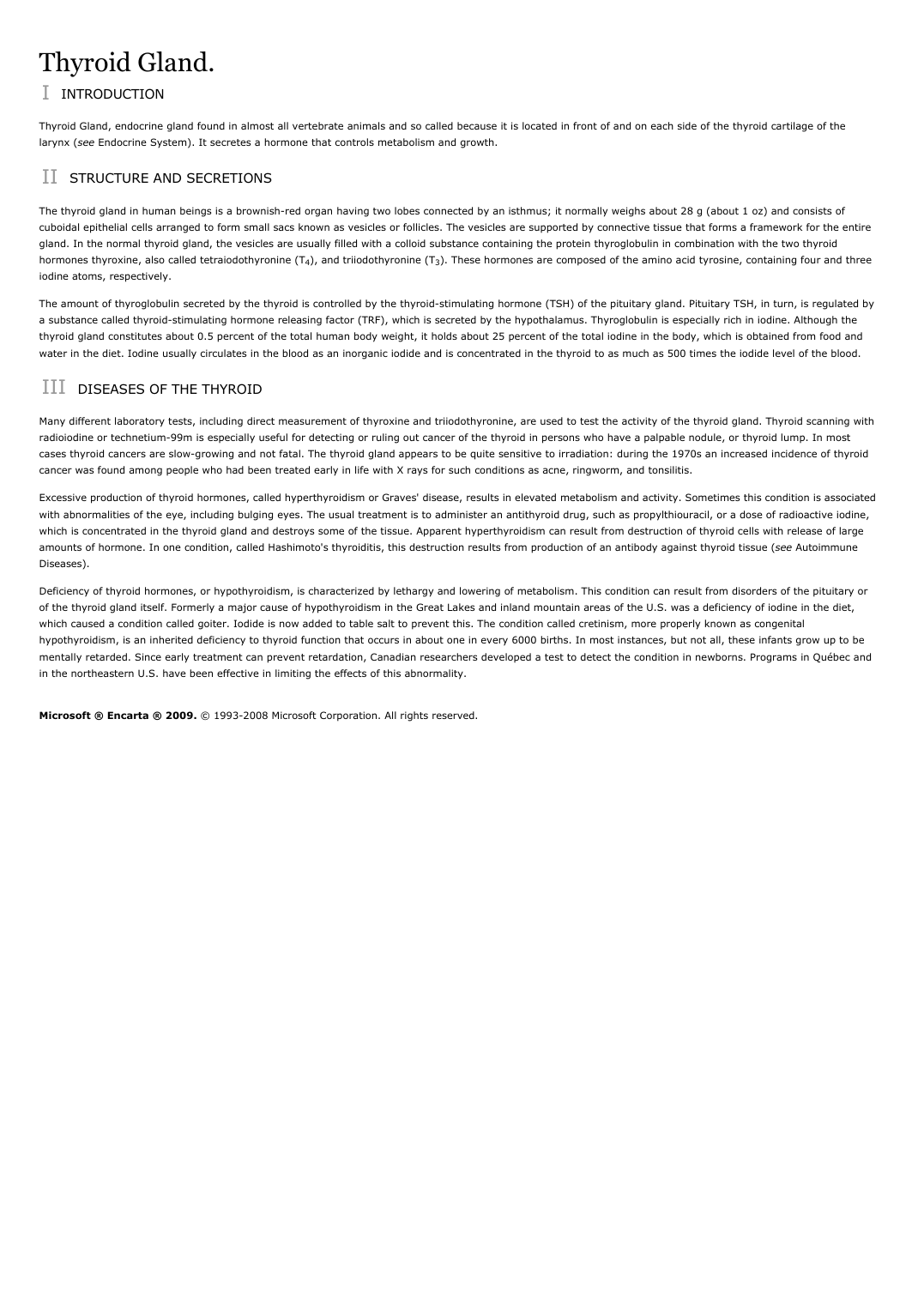Thyroid Gland.
Publié le 06/12/2021
Extrait du document
Ci-dessous un extrait traitant le sujet : Thyroid Gland.. Ce document contient 625 mots. Pour le télécharger en entier, envoyez-nous un de vos documents grâce à notre système d’échange gratuit de ressources numériques ou achetez-le pour la modique somme d’un euro symbolique. Cette aide totalement rédigée en format pdf sera utile aux lycéens ou étudiants ayant un devoir à réaliser ou une leçon à approfondir en : Echange
Thyroid Gland.
I
INTRODUCTION
Thyroid Gland, endocrine gland found in almost all vertebrate animals and so called because it is located in front of and on each side of the thyroid cartilage of the
larynx (see Endocrine System). It secretes a hormone that controls metabolism and growth.
II
STRUCTURE AND SECRETIONS
The thyroid gland in human beings is a brownish-red organ having two lobes connected by an isthmus; it normally weighs about 28 g (about 1 oz) and consists of
cuboidal epithelial cells arranged to form small sacs known as vesicles or follicles. The vesicles are supported by connective tissue that forms a framework for the entire
gland. In the normal thyroid gland, the vesicles are usually filled with a colloid substance containing the protein thyroglobulin in combination with the two thyroid
hormones thyroxine, also called tetraiodothyronine (T4), and triiodothyronine (T3). These hormones are composed of the amino acid tyrosine, containing four and three
iodine atoms, respectively.
The amount of thyroglobulin secreted by the thyroid is controlled by the thyroid-stimulating hormone (TSH) of the pituitary gland. Pituitary TSH, in turn, is regulated by
a substance called thyroid-stimulating hormone releasing factor (TRF), which is secreted by the hypothalamus. Thyroglobulin is especially rich in iodine. Although the
thyroid gland constitutes about 0.5 percent of the total human body weight, it holds about 25 percent of the total iodine in the body, which is obtained from food and
water in the diet. Iodine usually circulates in the blood as an inorganic iodide and is concentrated in the thyroid to as much as 500 times the iodide level of the blood.
III
DISEASES OF THE THYROID
Many different laboratory tests, including direct measurement of thyroxine and triiodothyronine, are used to test the activity of the thyroid gland. Thyroid scanning with
radioiodine or technetium-99m is especially useful for detecting or ruling out cancer of the thyroid in persons who have a palpable nodule, or thyroid lump. In most
cases thyroid cancers are slow-growing and not fatal. The thyroid gland appears to be quite sensitive to irradiation: during the 1970s an increased incidence of thyroid
cancer was found among people who had been treated early in life with X rays for such conditions as acne, ringworm, and tonsilitis.
Excessive production of thyroid hormones, called hyperthyroidism or Graves' disease, results in elevated metabolism and activity. Sometimes this condition is associated
with abnormalities of the eye, including bulging eyes. The usual treatment is to administer an antithyroid drug, such as propylthiouracil, or a dose of radioactive iodine,
which is concentrated in the thyroid gland and destroys some of the tissue. Apparent hyperthyroidism can result from destruction of thyroid cells with release of large
amounts of hormone. In one condition, called Hashimoto's thyroiditis, this destruction results from production of an antibody against thyroid tissue (see Autoimmune
Diseases).
Deficiency of thyroid hormones, or hypothyroidism, is characterized by lethargy and lowering of metabolism. This condition can result from disorders of the pituitary or
of the thyroid gland itself. Formerly a major cause of hypothyroidism in the Great Lakes and inland mountain areas of the U.S. was a deficiency of iodine in the diet,
which caused a condition called goiter. Iodide is now added to table salt to prevent this. The condition called cretinism, more properly known as congenital
hypothyroidism, is an inherited deficiency to thyroid function that occurs in about one in every 6000 births. In most instances, but not all, these infants grow up to be
mentally retarded. Since early treatment can prevent retardation, Canadian researchers developed a test to detect the condition in newborns. Programs in Québec and
in the northeastern U.S. have been effective in limiting the effects of this abnormality.
Microsoft ® Encarta ® 2009. © 1993-2008 Microsoft Corporation. All rights reserved.
Thyroid Gland.
I
INTRODUCTION
Thyroid Gland, endocrine gland found in almost all vertebrate animals and so called because it is located in front of and on each side of the thyroid cartilage of the
larynx (see Endocrine System). It secretes a hormone that controls metabolism and growth.
II
STRUCTURE AND SECRETIONS
The thyroid gland in human beings is a brownish-red organ having two lobes connected by an isthmus; it normally weighs about 28 g (about 1 oz) and consists of
cuboidal epithelial cells arranged to form small sacs known as vesicles or follicles. The vesicles are supported by connective tissue that forms a framework for the entire
gland. In the normal thyroid gland, the vesicles are usually filled with a colloid substance containing the protein thyroglobulin in combination with the two thyroid
hormones thyroxine, also called tetraiodothyronine (T4), and triiodothyronine (T3). These hormones are composed of the amino acid tyrosine, containing four and three
iodine atoms, respectively.
The amount of thyroglobulin secreted by the thyroid is controlled by the thyroid-stimulating hormone (TSH) of the pituitary gland. Pituitary TSH, in turn, is regulated by
a substance called thyroid-stimulating hormone releasing factor (TRF), which is secreted by the hypothalamus. Thyroglobulin is especially rich in iodine. Although the
thyroid gland constitutes about 0.5 percent of the total human body weight, it holds about 25 percent of the total iodine in the body, which is obtained from food and
water in the diet. Iodine usually circulates in the blood as an inorganic iodide and is concentrated in the thyroid to as much as 500 times the iodide level of the blood.
III
DISEASES OF THE THYROID
Many different laboratory tests, including direct measurement of thyroxine and triiodothyronine, are used to test the activity of the thyroid gland. Thyroid scanning with
radioiodine or technetium-99m is especially useful for detecting or ruling out cancer of the thyroid in persons who have a palpable nodule, or thyroid lump. In most
cases thyroid cancers are slow-growing and not fatal. The thyroid gland appears to be quite sensitive to irradiation: during the 1970s an increased incidence of thyroid
cancer was found among people who had been treated early in life with X rays for such conditions as acne, ringworm, and tonsilitis.
Excessive production of thyroid hormones, called hyperthyroidism or Graves' disease, results in elevated metabolism and activity. Sometimes this condition is associated
with abnormalities of the eye, including bulging eyes. The usual treatment is to administer an antithyroid drug, such as propylthiouracil, or a dose of radioactive iodine,
which is concentrated in the thyroid gland and destroys some of the tissue. Apparent hyperthyroidism can result from destruction of thyroid cells with release of large
amounts of hormone. In one condition, called Hashimoto's thyroiditis, this destruction results from production of an antibody against thyroid tissue (see Autoimmune
Diseases).
Deficiency of thyroid hormones, or hypothyroidism, is characterized by lethargy and lowering of metabolism. This condition can result from disorders of the pituitary or
of the thyroid gland itself. Formerly a major cause of hypothyroidism in the Great Lakes and inland mountain areas of the U.S. was a deficiency of iodine in the diet,
which caused a condition called goiter. Iodide is now added to table salt to prevent this. The condition called cretinism, more properly known as congenital
hypothyroidism, is an inherited deficiency to thyroid function that occurs in about one in every 6000 births. In most instances, but not all, these infants grow up to be
mentally retarded. Since early treatment can prevent retardation, Canadian researchers developed a test to detect the condition in newborns. Programs in Québec and
in the northeastern U.S. have been effective in limiting the effects of this abnormality.
Microsoft ® Encarta ® 2009. © 1993-2008 Microsoft Corporation. All rights reserved.
↓↓↓ APERÇU DU DOCUMENT ↓↓↓

































